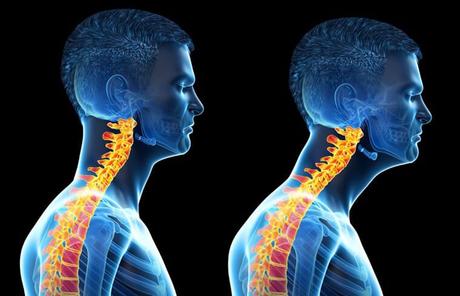In this article, we’re going to show you how to fix forward head posture in three simple exercises.
We know forward head posture is very common, but just because it’s common, doesn’t mean it’s normal. Lots of people have high blood pressure and high cholesterol.
It is still an abnormal clinical finding. Some people will present with forwarding head posture and have no complaints at all, no pain, no symptoms, but others present with associated symptoms, everything from neck pain to headaches, to a pinched nerve going down your arm, to balance issues, to dizziness, to fogginess.
We even see people struggling to heal from a lumbar disc bulge or herniation because their posture is so forward, compressing the bottom discs. We were never meant to sit for 8 to 10 hours a day having gravity work on us, pushing us more forward and moving forward. This can be devastating to our spinal health.

The Most Common Cause of forwarding Head Posture
We want to take to explain the most common cause of forwarding head posture. And it’s not a problem with the neck. So gravity is constantly acting on us. We’ve assumed poor postural habits. We don’t move enough. Our muscles weaken, our ligaments lengthen, and we have poor spinal alignment.
- The first thing that happens, is we assume a lazy posture, this allows our thoracic spine to start to shift forward, without even addressing the neck. You can see as your thoracic, as you see hunch forward, your spine shifts forward jetting your head out, what happens then is your neck needs to compensate, and it goes into hyperextension, really firing your suboccipitals just underneath the base of your skull. You’re going to find this gets tight. And then finally, what happens is you would assume a posterior pelvic tilt, a loss of curve in the lower back, to assume this posture.
- The primary we need to correct is right here. If we can fix this spot, this will help correct the other areas in the spine that are compensating for the poor thoracic posture. We call that thoracic hyperkyphosis or increased flexion through the mid back. What we’re going to show you is how to fix this area to help fix that forward head posture and those associated symptoms. I would like you to visualize a mirror image.
What does mirror image mean?
It means trying to take this posture and move it in the exact opposite direction. Mirror image in terms of the strengthening of the muscles, the ligaments stretch, and the neuromuscular coordination or activation is essential to fixing this faulty postural pattern. And finally, if you have any symptoms associated with your forward head postures, like a pinched nerve, dizziness, or headaches, this is something you should consult a professional with. They’re in a position to provide you with more specific care and testing to make sure the correction happens as efficiently and safely as possible.

What Does Mirror Image Mean?
It means trying to take this posture and move it in the exact opposite direction. Mirror image in terms of the strengthening of the muscles, the ligaments stretch, and the neuromuscular coordination or activation is essential to fixing this faulty postural pattern. And finally, if you have any symptoms associated with your forward head postures, like a pinched nerve, dizziness, or headaches, this is something you should consult a professional with. They’re in a position to provide you with more specific care and testing to make sure the correction happens as efficiently and safely as possible.
Thoracic Outlet Syndrome Physiotherapy Of Shoulder Impingement Syndrome3 Easy Exercises to Fix Forward Head Posture
First Exercise
Remember a single stretch or a single exercise of a single muscle group will not work to fix forward head posture. These movements that are going to show you these three simple exercises are going to be movements that involve many muscles, joints, and ligaments. What you’re going to need for this one. You’re gonna need a small towel or a face cloth just for some padding. And what we’re going to do is we’re going to visualize and think about that mirror image exercise, or that mirror image position, the opposite of this position. So we’re going to take our small little towel or face cloth when we’re going to get against the wall, and we’re gonna hold it there. So think about the first thing you want to do is let’s pull your shoulders back. Let’s get our shoulders back. And if your head’s off the wall, you’re going to find that you have to pull it up. And as you pull it back and you might want to extend your head because your suboccipital is tight. What you want to do is you want to make sure you tuck your chin, and you pull your chin down and back into the face cloth. So again, chest up shoulders back, chin tuck, and what we’re going to do, just this position might be difficult to get your head where it needs to be, but this is the right position. And you need to take a few steps out. And then what we’re going to do to fire those muscles, we’re going to pull and pull our chin towards the wall. We want our head over the top of our shoulders, over top of her hips, nice position chest up. And we want to hold this position for 2 to 3 minutes. And for some of you, this might be difficult, but start slow 5, 10, 15 seconds, whatever you can do, hold your shoulders back, pull them down, really take your chin and pull it in and use this as leverage to fire those muscles. You can feel it deep in the muscles, in the neck and your suboccipital area. You will also feel it in your trapezius muscles. The other thing you want to be aware of when you’re doing this is because often this posture involves a posterior pelvic tilt. When you’re in the position, basically what you want to do to alleviate this is to mirror image it, and extend your glutes just a little bit in this position. And again, tuck, you want to try to keep that nice and straight in the right alignment. That exercise is probably one of the best exercises you can do, to help that hunched forward posture or that forward head posture.
Second Exercise
For the next exercise, we’re going to do a scapular placing exercise, but we’re going to emphasize the middle part of our back. For this exercise, we’re going to get on our stomachs or we’re going to lie prone. We’re gonna place our hands behind us. We want to take our chin and tuck it and hold it right away. You should feel this in your middle traps. We’re going to pull our shoulders back and elevate them off of our, off the floor or a table. And we’re going to pull our shoulders down with a chin tuck. We’re gonna hold this for 10 seconds, and they’re going to rest. We’re going to chin tuck, shoulders back, plus down, point to our toes so to speak and hold, and relax. So for this exercise, you can do this 10 sets a day and hold for 10 to 15 seconds, really focused on pulling your shoulders back, talking to your chin, and extending your thoracic spine to work all the areas of the faulty posture pattern In a mirror image position.
Third Exercise
For the final exercise or movement. This is an area where I find a lot of people do quite well with the exercise’s trying to fix their posture, but they often forget about another tissue. Ligaments. Ligaments are what give our spine stability. The problem is if your spine is out of alignment for a long period, the ligaments tighten up around that new position. So they need to be stretched, and they need to be stretched slowly. There’s a phenomenon called ligament creep. And what that means essentially is over some time, the ligaments will slowly creep or stretch. The problem is it takes them at least at minimum five minutes for them to get started. And up to 15 to 20 minutes, to get them to their full length. We need to stretch the ligaments to allow the exercises to help hold our posture in the correct form. So for this traction or stretch, you can use either a pool noodle, a rolled towel, or a foam roller, if you have it. But what we’re going to do a little bit differently here is we’re going to focus on our mid-thoracic spine to mirror image the faulty, lazy postural pattern that we all have. So take your towel or your pool noodle. We’re going to get this between our shoulder blades. That’s where we want it. It might take a bit of maneuvering to get it in the right spot, but once you feel that your thoracic cage or your rib cage opens up, you know you’re in the right spot. To start to make it easy we might want to keep your legs bent, but then you’re going to extend over the top, just like this, let your shoulders roll out. That feels good. You can keep, keep your arms out to the side If you want a little more stretch. You need to stay in this position for a minimum of 5 minutes, but you can do this up to 15 to 20 minutes a day. For some of you that want to help with the neck curve. What you can do is you can kind of edge back. You can either put a towel under your neck, a smaller towel, or if you’re on the edge of a bed, you can kind of just kind of edge back and get your head slightly extended off as well. Open again, open up the shoulders, and think happy, healthy thoughts. It’s a nice time to relax, push the stress out of your head, and just relax into the stretch.
You’re going to probably have more energy. You’re going to feel like you’re more upright, and your day is just going to be better.
If you do those two exercises and that last stretch we know if you do that every day, you will notice a difference in your forward head posture and hunched forward posture within 30 days.

Tips to Help Prevent your Posture from Relapsing Back into that Old Routine
We’re going to leave you with three final tips to help prevent your posture from relapsing back into that old routine and to prevent future problems from happening.
- The first thing you need to do is to make sure, and this will take some practice, that you’re breathing through your belly and not that tight chest, stressful breathing. The more you breathe through your belly, it naturally allows you to stand up more straight, take more oxygen and be less stressed throughout your day.
- The second thing for those that sit for eight to 10 hours a day, put a reminder on their phone. Every 30 minutes, have an alarm go off just to remind you to get up, get a glass of water, move around, breaking your faulty, postural pattern, your sustained positions and just the fact that you’re under gravity, every 30 minutes or so will go a long way in helping you maintain the posture you desire.
- Finally, when you are moving around your day, when you’re exercising, you’re on a treadmill, you’re doing weights. Think of one simple thing. Take your sternum and make sure it’s pointing up. Don’t let your sternum point down. Don’t think of anything except for your sternum. When you’re walking, when you’re exercising on a treadmill or running, keep that sternum to the sky, and it will help maintain proper posture.
Another cause of neck pain is improper desk use when working, studying, or doing some activities at home. This can result in lower back pain, fatigue, and forward head posture. With the features of an ergonomic desk, such as adjustable height and angle, back frame, reclining mechanism, lumbar support, and comfortable seat will definitely be a great answer on how to fix posture-related problems.
Physio2Health can help you with solving these issues.

